July 13, 2018
Air Date: July 13, 2018
FULL SHOW
SEGMENTS
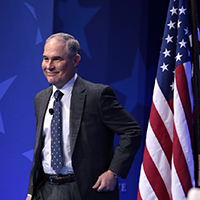
Pruitt Out, Wheeler In
View the page for this story
With the departure of EPA Administrator Scott Pruitt, former coal lobbyist and Senate staffer Andrew Wheeler now takes over as Acting Administrator, and is expected to keep rolling back regulations. Britt Erickson, a senior editor at Chemical and Engineering News, spoke with Host Steve Curwood about what’s at stake in the EPA transition. (08:20)
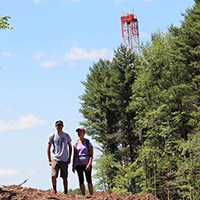
Fracking On The Rachel Carson Trail
/ Reid FrazierView the page for this story
Near Pittsburgh, a popular hiking trail named after a hero of the environmental movement winds up and down hilly terrain, passing busy suburban roads, power lines, pipeline rights-of-way and even a coal ash pile. Now, a shale gas well has been added along the trail and as the Allegheny Front’s Reid Frazier reports, some hikers aren’t happy about this latest industrial feature. (04:30)

Judge Kavanaugh & Environmental Protection
/ Jaime KaiserView the page for this story
President Trump has nominated Appellate Judge Brett Kavanaugh to replace retiring US Supreme Court Justice Anthony Kennedy. Vermont Law School Professor Pat Parenteau tells Host Jaime Kaiser how Judge Kavanaugh’s conservative record could affect a range of environmental issues from endangered species protections to climate action. (11:20)

Beyond The Headlines
/ Peter DykstraView the page for this story
Peter Dykstra and Host Steve Curwood discuss the high rates of solar panel ownership among National Rifle Association members and the record temperatures that have scorched the Northern hemisphere. Later, they look back on the blight epidemic that nearly wiped out the American Chestnut tree in the early half of the 20th century, and share good news about this iconic species’ gradual comeback. (05:15)
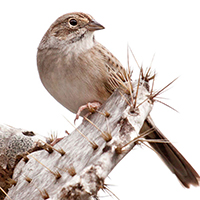
BirdNote: Sparrow Sing In Arizona Monsoon
/ Michael SteinView the page for this story
The hot, dry early summer months in the desert Southwest usually give way in July to the intense rains of the monsoon season. And as BirdNote®’s Michael Stein reports, this reprieve from the searing drought gripping the Southwest can bring life back to the desert as some sparrows take the rain as a cue to begin their courtship songs. (02:10)
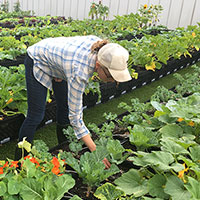
Hospital Farming For Better Health
/ Jaime KaiserView the page for this story
Boston Medical Center, a major trauma center and teaching hospital, is reimagining what it means to care for patients, with a new rooftop agriculture project. Living on Earth Host Jaime Kaiser visited the hospital to learn more about the farm, which is providing fresh produce for patient and employee meals. (07:15)
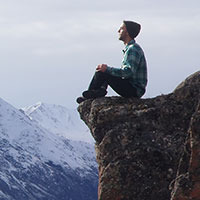
The Place Where You Live: Anchorage, Alaska
View the page for this story
Living on Earth gives a voice to Orion Magazine’s longtime feature, “The Place Where You Live,” in which readers write about their favorite places. In this week’s edition, teacher Sasha Johnson shares her essay on living in Anchorage, Alaska, a place of bold, adventurous folks willing to endure hardship in chasing their dreams. (06:15)
Show Credits and Funders
Show Transcript
HOSTS: Steve Curwood, Jaime Kaiser
GUESTS: Britt Erickson, Pat Parenteau
REPORTERS: Peter Dykstra, Reid Frazier, Michael Stein
[THEME]
CURWOOD: From Public Radio International – this is Living on Earth.
[THEME]
CURWOOD: I'm Steve Curwood.
KAISER: And I’m Jaime Kaiser.
A new conservative on the US Supreme Court could bring big changes to environmental law.
PAT PARENTEAU: With Kennedy gone and with Kavanaugh replacing him, there's a very real risk that the Massachusetts vs EPA precedent, the most important single judicial decision we have on climate change, could be subject to either being overruled or greatly modified.
CURWOOD: Also, EPA Administrator Scott Pruitt may be gone, but his agenda lives on.
ERICKSON: I think we'll continue to see the EPA administrator sideline science. I think we'll have delays in health risk assessments, we'll see delays in restrictions on chemicals. We won't see any type of restrictions probably.
CURWOOD: Those stories this week on Living on Earth – Stick Around!
[NEWSBREAK MUSIC: Boards Of Canada “Zoetrope” from “In A Beautiful Place Out In The Country” (Warp Records 2000)]
[THEME]
Pruitt Out, Wheeler In
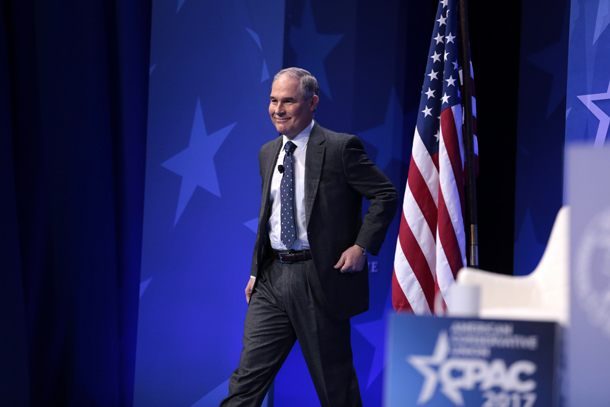
Scott Pruitt, the former EPA administrator, has resigned amid a number of ethics scandals. (Photo: Gage Skidmore, Wikimedia commons, CC BY-SA 2.0)
KAISER: From PRI and the Jennifer and Ted Stanley Studios at the University of Massachusetts, Boston, this is Living on Earth. I’m Jaime Kaiser.
CURWOOD: And I’m Steve Curwood.
Former EPA Administrator Scott Pruitt who was forced to resign July 5th amid 13 different federal investigations was also slow to get his job done. On July 10th, as Deputy Administrator Andrew Wheeler took charge as acting head, the EPA finally delivered to the White House a proposed rule to replace the Clean Power Plan, though Mr. Pruitt had announced he would do it back in March of 2017. Mr. Wheeler is a former coal lobbyist and senate staffer and his critics expect him to follow Scott Pruitt’s pattern of sidelining science. Andrew Wheeler has been skeptical of climate science and proposed regulations under TSCA, the updated Toxic Substances Control Act. For a look at what’s ahead for the EPA, Britt Erickson, senior editor at Chemical & Engineering News, joins us. Welcome to Living on Earth!
ERICKSON: Thanks for having me.
CURWOOD: So, remind us what the EPA is in fact responsible for regulating and what you see are some of the biggest risks in this transition from Mr. Pruitt to Mr. Wheeler.
ERICKSON: Well, under TSCA, EPA is regulating chemicals – new chemicals that come onto the market. They're required to look at the safety of these chemicals to make sure there is no risk to human health before they go on to the market. Under Pruitt, they kind of sidelined the science. They look the other way… they say, well, we're just going to look at very small uses of the chemical rather than all the comprehensive uses of the chemical. So, we end up with no risk.
CURWOOD: And so, what can we expect now going forward?
ERICKSON: I think we'll continue to see the EPA administrator sideline science. I think we’ll have delays in health risk assessments. We'll see delays in chemical bans. We'll see delays in restrictions on chemicals. We won't see any type of restrictions probably.
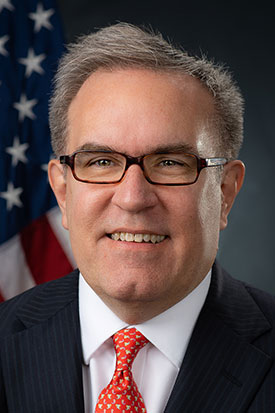
Andrew Wheeler, a Washington insider and former coal lobbyist, has replaced Scott Pruitt as EPA administrator. (Photo: United States Environmental Protection Agency, Wikimedia commons, public domain)
CURWOOD: Yeah, what about these reports that Scott Pruitt had been delaying the release of a report on human health effects from formaldehyde? Now that Mr. Wheeler is there, how might that change – and by the way, what's this all about, the formaldehyde thing?
ERICKSON: So, the formaldehyde assessment has been going on for a very long time. Under Senator Inhofe, I believe, when Andrew Wheeler was working for Senator Inhofe, the EPA delayed the assessment because Inhofe was pushing them to do so. And I believe we'll see more of the same. Under Wheeler, we're going to see more delays. They've never released this assessment. Current staff at EPA is saying that they've been told to delay it.
CURWOOD: So, talk to me about some of the other chemical and pollutant laws that have been, well, pushed around by Scott Pruitt's legacy.
ERICKSON: Well, one of the ones I'm very concerned about is methylene chloride in paint removers. Under the Obama administration, the EPA had proposed to ban that use. When Scott Pruitt came on board, the ban was delayed. He then met with several families that had sons – young men – who had passed away from using this chemical that they had purchased at their local hardware store. So, he promised… Pruitt promised that he would do something about this and finalize the methylene chloride rule. He did not, so now it's up to Wheeler to do so, and we don't know whether he will.
CURWOOD: Now, what about the pesticides Mr. Pruitt sat on moving forward with some of the regulations – indeed, went against what some of the recommendations of his science panels had on some of these pesticides. What are the chemicals we're talking about here, and what might be happening with them now?
ERICKSON: That's correct. Chlorpyrifos is a big one that when Pruitt came on board, he decided to put that ban on hold. That was a proposal under the Obama administration, and so that's been sitting. There are lawsuits about that. This is a pretty nasty chemical. It affects children's nervous systems, neurodevelopmental effects in children. It affects pregnant women, it affects the unborn. It's used very widely.
CURWOOD: For what kind of things it is used for?
ERICKSON: Just about every crop out there. I believe it's your specialty crops, nuts and orchards, and there's a whole slew of vegetables that it's used on.
CURWOOD: So, I gather industry was not happy at the prospect of it perhaps not being able to be used or being highly restricted in its use.
ERICKSON: That's correct. This is a huge moneymaker for the chemical industry.
CURWOOD: What other pesticides should we be concerned about at this point?
ERICKSON: One that I'm very concerned about personally is a new herbicide on the market called dicamba. Now, this came out just last year. It was probably the first time it was widely used, but this year it's doubled the usage and we're starting to see a drift problem. So, it's not staying on the intended target, which is soybeans and cotton. These are genetically modified crops that are resistant to the herbicide. But when the herbicide drifts off the field into the neighbor's field, it will kill everything that has a broad leaf. So, I'm talking about vegetable gardens, grapes, orchards, peaches, any broad leaf landscaping plants. So, you can see the problem where you have residential areas next door to a soybean field, and you have this large amount of drift – which can go, what I hear, up to a mile under some conditions. We've got trees that are dying. We have maple trees that are dying. We have beautiful Mimosa trees that are dying. This is a huge problem all across the US. Missouri last year, there was a murder over this.
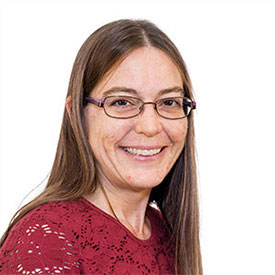
Britt Erickson is a Senior Editor at Chemical and Engineering News. (Photo: Chemical and Engineering News)
CURWOOD: A murder?
ERICKSON: A farmer went against his neighbor and shot him because his neighbor drifted herbicide on to his land. So, this is going to get ugly this year, I predict.
CURWOOD: Now, Scott Pruitt was, can we say, flamboyant. He came right as a bright light there in Washington. What's the reputation of Andrew Wheeler in terms of publicity and the prospect of a very visible scandal, do you think?
ERICKSON: Well, I think he's much more careful. I think he'll be following the law more carefully than Pruitt was doing, and he also has a lot of allies on Capitol Hill. Remember, he worked for Senator Inhofe, so he's got a lot of connections on the hill. He can make things happen. He has a charm about him that he can get along with both sides, so I think he will try to please the environmentalists much more so than Pruitt ever would want to do.
CURWOOD: So, tell me, what's the mood inside the Environmental Protection Agency after this transition?
ERICKSON: You know, that's a good question. I think the morale was so low when Pruitt was there. That's going to be very hard for Wheeler to rebuild morale. I think a lot of senior leadership has left, and they really need to start over basically. He's got a hard time ahead of him.
CURWOOD: To what extent might he garner more respect from folks who have spent their careers at the EPA compared to Mr Pruitt, do you think?
ERICKSON: Well, what I've heard is that he has a good ear. He's listening to the staff. He's actually coming around and talking to people, which Pruitt never did. So, he is asking people, what issues are you facing, and he seems to be genuinely concerned. So, that's a good sign.
CURWOOD: So, the senior scientists are – sounds like they're getting more respect from him at least on a personal level, but what are their concerns about the outcomes that might result from his leadership there?
ERICKSON: Well, looking at his background, I think there's some concern. He worked for the fossil fuel industry. There is concern that he will not move forward with any regulations against that industry. Things like the climate change rules, the CO2 emissions from power plants – we're likely to see no progress in that area. A lot of career staffers really believe in protecting the environment, and if you cannot do that under your leadership, it makes your job very difficult.
CURWOOD: Britt Erickson is a Senior Editor at Chemical & Engineering News. Thank you so much.
ERICKSON: Thank you for having me.
Related links:
- The New York Times: “E.P.A Chief Scott Pruitt Resigns Under a Cloud of Ethics Scandals”
- POLITICO: “Sources: EPA blocks warnings on cancer-causing chemical”
- EcoWatch: “Dicamba Damage Roars Back for Third Season in a Row”
- Listen to our previous story with Britt Erickson on TSCA
[MUSIC: Kim Richey, “Texas Girl At the Funeral Of Her Father” on Sail Away: The Songs Of Randy Newman, by Randy Newman, Sugar Hill Records]
Fracking On The Rachel Carson Trail
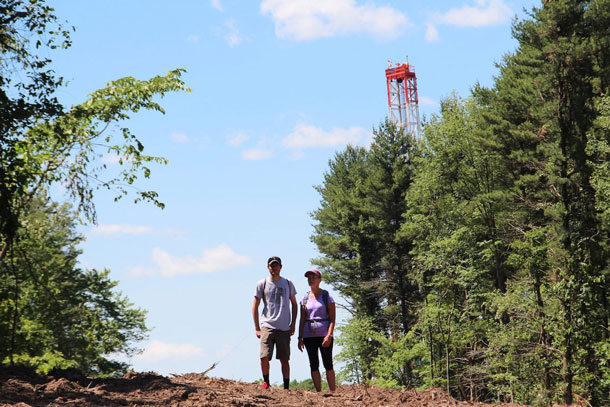
Kathleen Ganster with her son Kenton on the Rachel Carson trail near Pittsburgh. (Photo: Reid Frazier)
KAISER: Around a thousand hikers recently took part in the Rachel Carson Challenge.
It’s a 35-mile hike outside Pittsburgh along a trail named after one of the region’s most famous residents, credited with inspiring the modern environmental movement. But hikers this year saw a new addition on the trail: the fracking industry. Reid Frazier of the Allegheny Front has our story.
FRAZIER: Bob Mulshine is in charge of the Rachel Carson Challenge, an increasingly popular endurance hike through Pittsburgh’s northern suburbs. He’s a five-time finisher of the challenge, a brutal sunup to sundown march up and down hilly terrain. Many don’t finish.
A few days before the one-day hike is set to begin, Mulshine is taking me out to see the route. We hike over a wooded knob. Then, the woods end.
MULSHINE: So that's a nice wide swath.
FRAZIER: We look out over a pipeline right-of-way, about 50 feet wide.
FRAZIER: So this is the trail right here?
MULSHINE: Yes.
FRAZIER: Or was?
MULSHINE: Or was.
FRAZIER: Where once there was a forest, now there’s a clear cut alley leading to a drilling rig, a few hundred feet away, which Mulshine just now notices.
MULSHINE: Oh, and there is the drill site… Now that this is cleared, you can see it. I had not seen that before.
FRAZIER: Mulshine’s surprised, but he’s happy with the work he sees.
MULSHINE: So the trees have been taken down and removed. There’s no big…
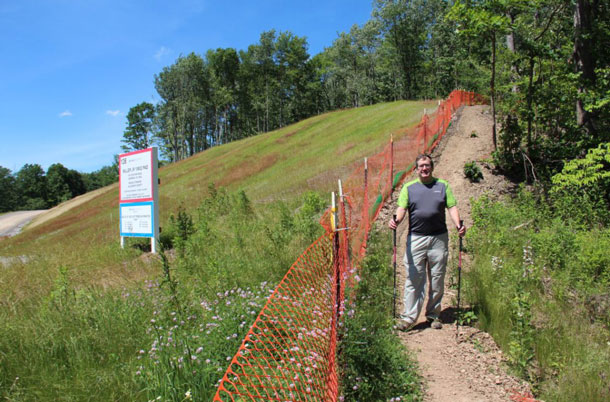
Bob Mulshine, president of the Rachel Carson Trails Conservancy, on a relocated section of the trail near a Marcellus shale gas well. (Photo: Reid Frazier)
FRAZIER: The rig is for a Marcellus shale well pad that Range Resources is developing here, on a portion of the trail in Indiana Township. To build the pad, the company rerouted a portion of the trail not far from here.
This year, Mulshine says, hundreds of hikers will see the drilling operations as they pass by. His main concern is that hikers don’t get lost when they cross this pipeline right-of-way.
MULSHINE: All we would have to do is put some kind of markers out that would keep people walking right across that. And for us as a hiking group, this is not an inconvenience.
FRAZIER: Mulshine says this is the first time there’s been fracking along the Rachel Carson, but it’s hardly the only industrial activity on the route. The trail skirts busy suburban roads, power lines – even a coal ash pile. He says the Marcellus shale industry is just another impediment to navigate around.
MULSHINE: We don't own any of the trail. We do not control this property at all. We walk totally at the… from the generosity of our volunteers who maintain the trails and the landowners and the people who control the land, when they give us their permission to use it.
FARZIER: Still not everyone is happy about the drilling. Kenton Ganster has hiked the Rachel Carson Challenge. Today he’s hiking a section of the trail with his mother, Kathleen, who’s done the Rachel Carson challenge four times and volunteers for the non-profit that runs it. He says it was a shock to see a drilling rig so close to the trail.
GANSTER: Yeah, it's just not something you really want to see. It's like a strip mine or anything else like that. You just really don't want to see it out here when you're coming to get away from all the industrialism and everything.
FRAZIER: Even though he doesn’t like having the drilling rig so close to the trail, he thinks it’s good for the urbanites who hike it to be able to see where their energy comes from.
GANSTER: Silver lining kind of thing, I do think it's good for the Rachel Carson type of crowd people to see it, because – I mean, you can look at it and decide what you think, and you can smell it and decide what you think, you know what I mean. And just see, is that something you want in your backyard. Because that's essentially what this is, is Pittsburgh's backyard.
FRAZIER: Range Resources, which is a sponsor of the hike, didn’t respond to interview requests. But Mulshine said he’s happy with how the company has handled the situation.
MULSHINE: We were thrilled that a drilling company wasn't trying to force us out of the woods.
FRAZIER: But what would Rachel Carson – whose book “Silent Spring” helped launch the environmental movement in the ‘60s – think of fracking taking place along a trail named after her?
Mulshine says, he doesn’t know.
MULSHINE: Would she like this? She bought a place up in Maine, a very secluded place up in Maine. We're trying to find the best we can for the people that are living in the area.
FRAZIER: And doing that, he says, involves compromise, and cutting a trail around the obstacles.
I'm Reid Frazier.
KAISER: Reid Frazier reports for the Allegheny Front.
Related links:
- The Rachel Carson Trail Challenge
- Tribune-Review: “Fracking riles residents in Pittsburgh’s northeastern suburbs”
- The Life and Legacy of Rachel Carson
- The original story on The Allegheny Front’s website
[MUSIC: Simon Wynberg, “Nocturne” on Guitar Works, Narada Lotus]
CURWOOD: Coming up – the environmental record of US Supreme Court nominee Brett Kavanaugh. Keep listening to Living on Earth!
ANNOUNCER: Support for Living on Earth comes from the Gordon and Betty Moore Foundation and from a friend of Sailors for the Sea, working with boaters to restore ocean health.
[MUSIC: The Connells “Scotty’s Lament” (intro) on Boylan Heights 1987 TVT Records]
Judge Kavanaugh & Environmental Protection

President Trump signs the document officially nominating Brett Kavanaugh to become the next Associate Justice of the US Supreme Court. (Photo: Dan Scovino Jr., White House Director of Social Media, public domain)
CURWOOD: It’s Living on Earth, I’m Steve Curwood.
KAISER: And I’m Jamie Kaiser.
In a flourish of prime-time television, President Trump announced the nomination of Brett Kavanagh, a judge on the US Court of Appeals for the DC Circuit, to replace retiring Supreme Court Justice Anthony Kennedy.
While Justice Kennedy has a reputation as a moderate conservative who often tipped the balance in key cases, Judge Kavanaugh is seen as further to the right and could solidify conservative control of the high court for decades, should he be confirmed.
For a look at Judge Kavanaugh’s record on the environment, we turn to Vermont Law School Professor Pat Parenteau.
Welcome back to the program, Pat!
PARENTEAU: Thank you, Jaime. Good to be here.
KAISER: Of course, Judge Brett Kavanaugh moved to the forefront pretty quickly as a likely contender for the nomination. He was a front-runner, so this didn't come as a huge surprise to anybody, but what was your first reaction when you learned that President Trump had picked him?
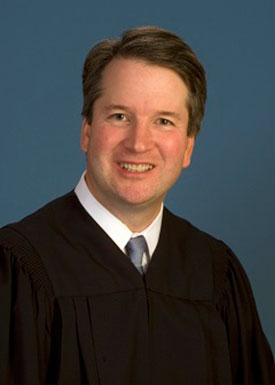
Judge Kavanaugh’s environmental decision record reflects a belief that environmental regulation should come about from more literal interpretation of the US Constitution and laws passed by Congress, compared to the discretion of regulators. (Photo: DC Court of Appeals, public domain)
PARENTEAU: Well, of the four finalists that we had heard the president had narrowed the list down to, I was not surprised that Kavanaugh would be a leading contender. But I have to say, from an environmental standpoint, based upon what I know about his track record of making decisions, he's probably the worst pick of the four. That may not be true of some other social issues, particularly things like Roe versus Wade that everybody's talking about. But when it comes to environmental law, the other three names on that list did not have much of a track record to begin with and might have been actually more open to seeing that environmental law oftentimes means regulation – oftentimes means federal regulation – and this is something that Brett Kavanaugh has been very skeptical about over his career.
KAISER: And so, why do you believe the president chose him?
PARENTEAU: Well, I mean the president asked for a list of eligible judges from the Federalist Society, and that's what he got. He got a list of 25 judges that the Federalist Society had hand-picked. He also consulted with the Heritage Foundation. These are obviously both very conservative, even right-wing, political entities in the country, and from there he winnowed it down to these four. So, I mean, this is a Supreme Court. Both Gorsuch and Kavanaugh, assuming he will be confirmed, which is probably inevitable – we will have a Supreme Court that has been tilted by, frankly, some very narrow special interests in the country.
KAISER: Although Brett Kavanaugh is relatively young, even Democrats wouldn't say that he's not experienced. I mean, he has a long-storied reputation in conservative legal circles. So, let's dig into some of the cases that he's heard about the environment and how they went.
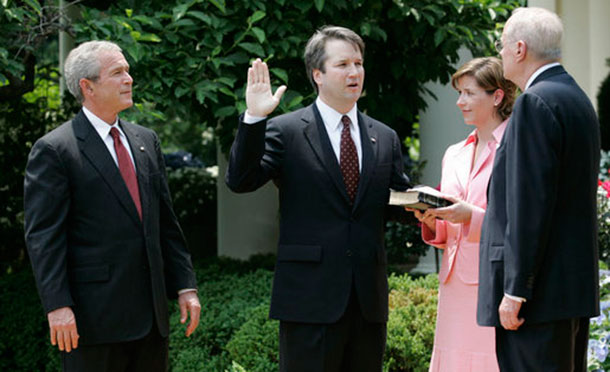
Brett Kavanaugh has been a Judge in the DC Circuit Court of Appeals since 2006. He was sworn in by Supreme Court Associate Justice Anthony Kennedy, for whom Judge Kavanaugh had previously clerked. (Photo: Official White House photo, public domain)
PARENTEAU: So, take the mercury rule, for an example. This is a very expensive rule in terms of what it would cost to meet the standards to protect public health. But Brett Kavanaugh, when the rule came to his court and his panel, immediately said, you need – EPA, you need to justify a rule like this with a lot more economic data than I see in this record. Now, ultimately, the mercury rule was actually upheld by the Supreme Court, but when Kavanaugh looked at the rule, he was not convinced that it should be upheld and wanted more economic justification. The same thing when it came to the Clean Power Plan. Of course, the DC Circuit heard arguments challenging the Obama Clean Power Plan, has never issued a decision, has been staying the effect of that case for the entire time that Trump's been in office. But, Kavanaugh during the oral argument was one of the few judges to express serious doubt about whether the courts should be involved in making policy on climate change.
KAISER: What can you say in terms of how he's been on cases dealing with endangered species or species protection?
PARENTEAU: Well, interesting you should ask that, Jamie, because the very first case on the docket of the Supreme Court in October is a case challenging protection of critical habitat for this little frog, the Dusky Gopher frog in Louisiana. The habitat in question is owned by the Weyerhaeuser company. Weyerhaeuser doesn't like the idea that the Endangered Species Act would apply to its property. So, if Kavanaugh is seated by October, which is Senator McConnell's goal, we'll find out right away what he thinks about the application of the Endangered Species Act to private property. That's going to be the telling point. Kavanaugh has shown a real concern for private property, a real concern for the costs of regulation on industry, and so this is a tailor-made case for him to say, I don't think the Endangered Species Act should be applied in this kind of a situation. And of course, when you think about it, the fate of most of the listed species – endangered species – depends on what happens on private land. After all, most of the land in the country is private.
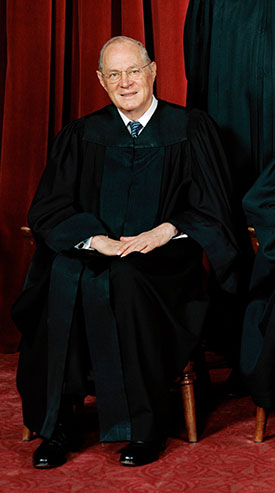
Associate Justice Anthony Kennedy announced his retirement from the Supreme Court in June of 2018. (Photo: US Supreme Court, public domain)
KAISER: To what extent does Kavanaugh acknowledge the reality of climate change, or to what extent has he shown the ability to consider climate science as evidence?
PARENTEAU: He has acknowledged the science behind climate change. Let me just say, Brett Kavanaugh is a brilliant lawyer and judge. That's what makes him in my mind a more formidable, if you will, adversary when it comes to extending environmental law. So, he doesn't question that climate change is real, that it's serious, that it demands attention. His point is, it's up to Congress to do it, not the courts. And my view is the courts do have a role in this process. He says courts are required to interpret the law, not make the law. That's a little disingenuous, frankly. When you look at the language of a statute, which is written very generally, often very ambiguous, subject to many different interpretations, the court is actually making a choice as to how to interpret the law. And by making that choice, they are making law. One message from this appointment is, we better redouble our efforts at the political level, and that means the electoral level, and that means November elections. We can't look to the courts. We certainly can't look to the Supreme Court at this point. We're going to have to change the Congress, elect people who are willing to look at the science and come up with creative approaches in a hurry, because we don't have a lot of time to address these problems. But the courts, I'm sorry to say, are a dead end.
KAISER: So, Pat, what are the chances that Brett Kavanaugh could end up becoming something of a David Souter? David Souter was appointed during the Reagan administration, was expected to be quite conservative, but really ended up being more moderate.
PARENTEAU: Well, that's a good comparison because David Souter was also a very – I would call him cerebral – intellectually curious about issues. So, you could say that the Supreme Court actually changed Justice Souter when he got there, and he began to grapple with some of these major issues, including actually some important environmental questions that came before the court when Souter was there. Kavanaugh is interesting in that I see the same kind of intellectual curiosity, and so there is certainly the possibility that Kavanaugh will change. And he may green up a little bit.
KAISER: Obviously, there's this vacancy because Justice Anthony Kennedy is retiring from the Supreme Court. Both Brett Kavanaugh and Gorsuch were actually clerks for Kennedy. How would you characterize Anthony Kennedy's legacy when it comes to the environment?
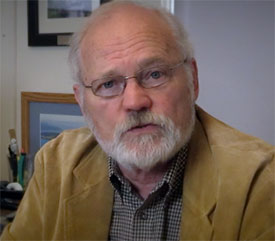
Pat Parenteau is a Professor at Vermont Law School. (Photo: Vermont Law School)
PARENTEAU: The thing about Kennedy was – and we can hope that Kavanaugh got some of this training from Kennedy – was Kennedy was a pragmatist. He was less an ideologue in sort of the most doctrinaire sense, and he was more of an incrementalist – which means Kennedy didn't like great big sweeping decisions other than, of course, marriage equality, which I think you can argue was a pretty sweeping decision. But in most of the environmental type cases where Kennedy was involved, he was looking at the issues from the standpoint of understanding the purpose of the statute. The best example I can give you is that Kennedy's concurring opinion in the infamous Rapanos case dealing with the Clean Water Act. And that opinion shows you that Kennedy was willing to engage with the science. He went into lots of the principles of ecology and how watersheds function and why it was important to protect streams and wetlands and so forth. He dug into the facts, and he wanted to be informed about why it was so complicated. You don't see many of the conservative justices like Scalia engaging in that.
KAISER: Now, what environment and public health cases are winding their way through the courts right now that could have a very different outcome with Kennedy gone and a conservative like Kavanaugh on the court?
PARENTEAU: Yeah, so the big one, of course, would be Massachusetts versus EPA where Kennedy was the critical fifth vote in favor of a ruling that EPA not only had the authority to regulate carbon pollution under the Clean Air Act, but it had the duty to do so once a determination had been made that carbon pollution threatens public health and welfare – which of course it does, there's no question about that. So, with Kennedy gone and with Kavanaugh replacing him, there's a very real risk that the Massachusetts versus EPA precedent, the most important single judicial decision we have on climate change, could be subject to either being overruled or greatly modified. And the way that will happen, even with Pruitt gone, his successor Wheeler is going to continue Pruitt's mission to adopt a Clean Power Plan that is so weak, it's almost laughable. And that plan, of course, will be challenged by many of the states and environmental groups that are pressing for stronger climate change regulations, and that will get to the Supreme Court. There's no question about it. It's a big enough issue. It will get there. And so Kavanaugh and Gorsuch are now in a position with the other conservatives on the court to rule in a way that basically could close the door to meaningful regulation of carbon pollution under the Clean Air Act.
KAISER: Pat Parenteau is a professor at Vermont Law School. Pat, thank you so much for coming on today.
PARENTEAU: Thanks for having me, Jaime.
Related links:
- The New York Times: “How Brett Kavanaugh Could Reshape Environmental Law From the Supreme Court”
- LegalPlanet: “Judge Brett Kavanaugh’s Record on the Environment”
- Pat Parenteau Profile
[MUSIC: Mika & Richard Stoltzman, “La Fiesta” by Chick Corea/arr.Edsel Gomez, Carnegie Hall 2013]
Beyond The Headlines
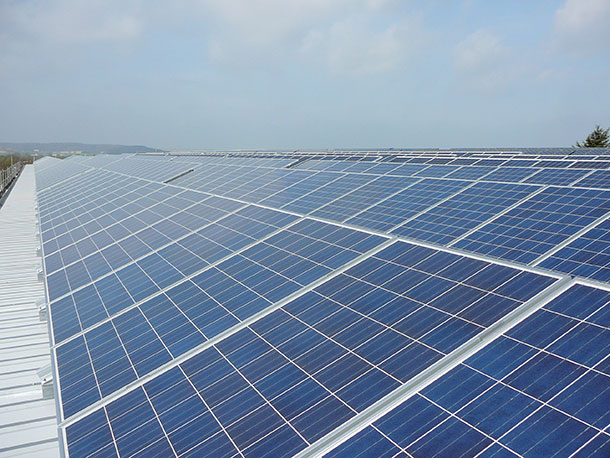
Solar panels and the clean energy movement go hand in hand, yet on average only 17 percent of the American population use them. (Photo: Christoffer Riemer – Own work, CC BY 3.0, Wikimedia Commons)
CURWOOD: Alright, let’s turn now to Peter Dykstra to look beyond the headlines. Peter’s an editor with Environmental Health News, that’s EHN.org and DailyClimate.org. He’s on the line now from Atlanta, Georgia, where, hey, it’s July, so it’s got to be hot down there?
DYKSTRA: Hi Steve. It’s actually a little bit cooler than we normally get here in July, but Atlanta’s an exception right now and in a minute, we’re going to talk about how hot it is in the rest of the northern hemisphere. Let me start with something that I found to be really surprising and I’m going to give you a little quiz. Can you tell me which well-heeled famous multi-million member American non-profit organization is showing surprising support among its members for buying solar panels?
CURWOOD: Let’s see, it has to be the National Wildlife Federation?
DYKSTRA: No.
CURWOOD: Or the AARP?
DYKSTRA: No.
CURWOOD: UNICEF?
DYKSTRA: Nope.
CURWOOD: YMCA?
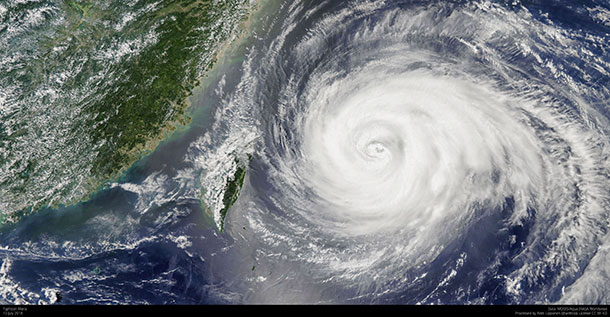
Typhoon Maria is seen approaching the coast of China on July 10, 2018. (Photo: Antti Lipponen, CC BY 2.0, Flickr)
DYKSTRA: No, no, no to all. It is the National Rifle Association, the NRA, according to a small survey done by a group called Swytch. According to their telephone survey, 38 percent of the NRA members they talked to said they own solar panels. That compares to a 17 percent national average. It’s just about 2 to 1.
CURWOOD: Wow. So how does that support by NRA members translate when it comes to the ballot box, or issues regarding, you know, spending government money on clean energy?
DYKSTRA: I’d say that NRA members are still going to vote for who likes guns and who doesn’t like guns, and that doesn’t necessarily bode well for clean energy candidates. I thought it was a noticeable stat. Another one in this telephone survey from Swytch said that red states, the ones that supported Donald Trump in the election, the ones that tend to elect Republican members of Congress and senators, support federal help for clean energy for 77 percent. That almost ties the support from blue states, which is at 80 percent. So, it almost doesn’t matter whether you like Donald Trump or not – you tend to want to see solar energy and wind energy succeed.
CURWOOD: So, red states are going green energy, but, hey, what about the weather you mentioned earlier?
DYKSTRA: Like I said, we’re going to talk about absurd temperatures in almost all of the northern hemisphere. This past week there have been records set across the globe. 108 degrees in Armenia. An all-time record 127 degrees in a town in Iran. Canada, which never sees hot temperatures, is seeing a heat wave that’s caused dozens of deaths. Denver – 104 degrees, that’s unheard of. LA, 111 degrees. And the one that really knocked me off my chair: Scotland, where it’s never hot, was 92 degrees this past week.
CURWOOD: Yeah, that’s right. You go to Scotland and you got to bring a sweater with you. But, it’s not just heat that’s behaving in an extreme way right now, is it?
DYKSTRA: Right, there are extremes in the other direction as well, and climate scientists will tell you every time that one weather event does not a proving fact make for climate change, but there are so many of them right now. Atlantic hurricanes: we’re already on our third named storm in early July. That normally doesn’t happen until early August. In China, Typhoon Maria, a huge typhoon early in the season. And in Japan, there’s been tragedy – triple figure death tolls from unprecedently heavy rains.
CURWOOD: Hm. Ok, let’s take a look back in the history vaults.
DYKSTRA: We’ll go back to July, 1906, when the New York Botanical Garden published a paper on an emerging blight and epidemic fungus that was beginning to take out American chestnut trees. Now the chestnut was an iconic tree in the early days of our country. It covered forests all over the eastern half of the US, and it was a favored wood because it was durable and it made for good fencing. It made for good furniture and it particularly made for good log cabins back in the day when we were settling this country.
CURWOOD: So, the blight virtually wiped out the trees. But I sense there’s a but here.
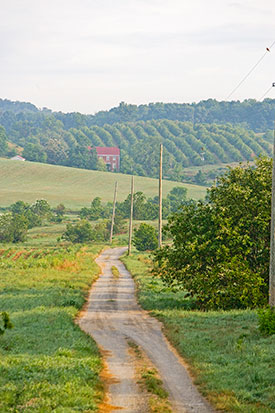
Meadowview Research Farms in Virginia is home to rows of American Chestnuts that are used in research efforts to revive the species. (Photo courtesy of the American Chestnut Foundation)
DYKSTRA: There is, if you pardon the expression, a big but, and that’s the American chestnut Tree was largely wiped out through the 20th century, but it may be on the way back. Through the American Chestnut Foundation working with various universities, they’ve been cross-breeding other species of chestnut tree – the Black chestnut, the Chinese chestnut – that are more resistant to chestnut blight, this fungus that’s wiped out American chestnuts. They’re seeing some results. It’s taken longer than they had hoped, but we may be witnessing one of the most spectacular comeback stories from a vanishing species than we’ve ever seen.
CURWOOD: Ah, indeed. That would be terrific. Thanks Peter. Peter Dykstra is with Environmental Health News, that’s EHN.org and DailyClimate.org. We’ll talk to you again real soon.
DYKSTRA: Alright Steve, thanks a lot. We’ll talk to you soon.
CURWOOD: And there’s more on these stories at our website, LOE.org.
Related links:
- Think Progress: “NRA members more than twice as likely to have solar panels as other Americans"
- Reuters: “At least 49 killed, 48 missing as torrential rain pounds Japan”
- EcoWatch: “Extreme Heat Wave in Quebec May Have Killed 70”
- American Chestnut Foundation
- Penn State Chestnut Research
[MUSIC: Lionel Hampton and His Orchestra, “Blues” on Lionel Hampton and His Orchestra: Featuring Clifford Brown, by L. Hampton, Jeal Records]
KAISER: Coming up – A major teaching hospital looks to its own roof as a source of food as medicine.
That’s just ahead on Living On Earth – Keep Listening.
ANNOUNCER: Funding for Living on Earth comes from you our listeners and United Technologies, combining passion for science with engineering to create solutions designed for sustainability in aerospace, building industries, and food refrigeration. UTC companies such as Otis, Carrier, Pratt and Whitney, and UTC Aerospace systems are helping to move the world forward. You can learn more about United Technologies by tuning into the Race to Nine Billion podcast; listen at race to nine billion dot com. That’s race to nine billion dot com. This is PRI, Public Radio International.
[MUSIC: Lionel Hampton, “Shoe Shiner’s Drag” on The Complete Lionel Hampton Victor Sessions, 1937-1941, Disc 2, by Jelly Roll Morton/arr.Edgar Sampson, Mosaic Records]
BirdNote: Sparrow Sing In Arizona Monsoon
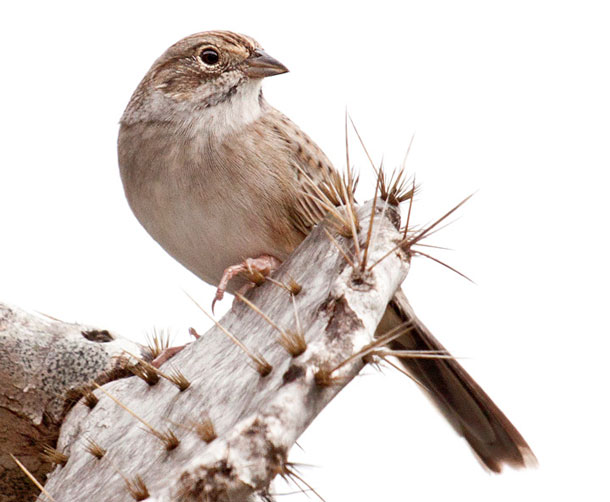
A Cassin’s sparrow perched on a cactus. (Photo: Bill Bouton)
KAISER: It’s Living on Earth. I’m Jaime Kaiser.
CURWOOD: And I’m Steve Curwood.
[MUSIC: BIRD NOTE THEME]
CURWOOD: The desert Southwest is in the midst of an extreme drought. The tinder-dry conditions have prompted rare national forest closures in Colorado, New Mexico, and Arizona to reduce the risk of someone sparking a devastating forest fire. And as BirdNote’s Michael Stein tells us, even some desert birds hold back their sweet songs of courtship as long as the land remains bone-dry.
BirdNote®
Sparrows Sing in the Arizona Monsoon
[Arizona desert summer soundscape just before the thunderstorm]
STEIN: In July in Southeast Arizona, midday temperatures soar above 100 degrees. A cicada’s high-pitched whine adds an edge to the searing heat.
[Intense whine of cicadas in Arizona desert heat]
But relief is coming. [Lightning and thunder]
The monsoon season begins. Winds from the south draw tropical moisture northward into the Sonoran Desert. Moist air colliding with intense heat and mountainous terrain breeds epic thunderstorms.
[Continue thunderstorm fading to rain and aftermath]
Rainfall rejuvenates the arid land. Grass grows lush, wildflowers spring forth, gullies once dusty now rush with water.
[Rushing rain water]
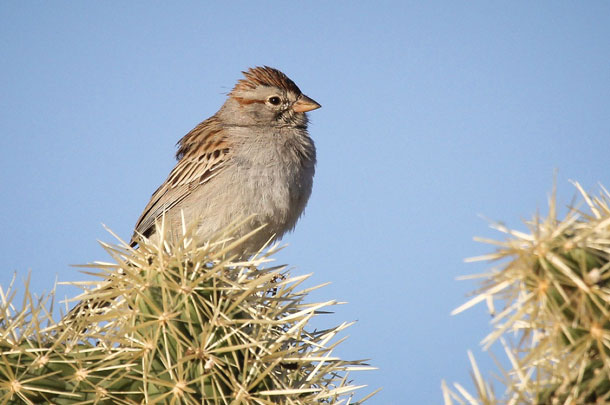
A rufous-winged sparrow. (Photo: Patty Bruno)
And birds sing. [Cassin’s Sparrow song] Cassin’s Sparrows have waited for the late summer rains to begin their courtship. Now the males sing their plaintive phrases almost nonstop. [Cassin’s Sparrow song] Botteri’s Sparrows add their distinctive sputters and trills. And a Rufous-winged Sparrow voices its gentle melody. [Rufous-winged Sparrow song]
[Thunderstorm and rain]
The summer monsoon refreshes the desert world like a second spring.
[Cassin’s Sparrow song]
I'm Michael Stein.
###
Written by Bob Sundstrom
Desert thunder birds + high-pitched whine of insects + rainy desert thunder recorded by Gordon Hempton of QuietPlanet.com. Also, sounds from Hempton’s Essentials – thunder #7 and rain storm aftermath #15.
Bird sounds provided by The Macaulay Library of Natural Sounds at the Cornell Lab of Ornithology, Ithaca, New York. Song of Cassin’s Sparrow [50231] recorded G.A. Keller; Song of Botteri’s Sparrow [112634] recorded by C.A.Marantz; Rufous-winged Sparrow [112637] recorded by C.A. Marantz.
BirdNote’s theme music was composed and played by Nancy Rumbel and John Kessler.
Producer: John Kessler
Executive Producer: Chris Peterson
© 2018 Tune In to Nature.org Narrator: Michael Stein
http://birdnote.org/show/sparrows-sing-arizona-monsoon
CURWOOD: For pictures and more about the Cassin’s Sparrow, go to our website, LOE.org.
Related links:
- About the Cassin’s Sparrow
- About the Botteri’s Sparrow
- About the Rufous-winged Sparrow
- Watch a Cassin’s Sparrow exhibit “skylarking” behavior
- The status of Arizona’s drought
[MUSIC: Richard Stoltzman, “In the Morning” on New York Counterpoint, by Charles Ives, SME on behalf of RCA Red Seal]
Hospital Farming For Better Health
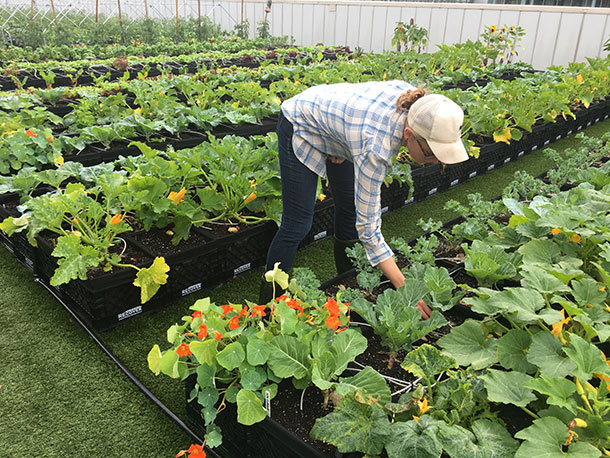
Farm manager Lindsay Allen says that Boston Medical Center’s rooftop farm features roughly two dozen crops. (Photo: Jaime Kaiser)
CURWOOD: Hey Jaime, I heard you were in a hospital recently?
KAISER: I was, but don’t worry, I’m in fine health.
Curwood: Oh, good but hey, why were you there?
KAISER: I actually stopped by Boston Medical Center to check out a new farm they’ve
started up.
CURWOOD: A hospital that’s farming?
KAISER: [LAUGH] I was surprised too…
[CITY AMBI]
KAISER: For one Boston hospital, feeding patients is about more than taking in calories. Food is medicine here, and they’re getting that food from an unusual location.
ALLEN: We’re up here on the rooftop farm here at Boston Medical Center. And right now we are on top of the powerplant shipping and receiving building.
KAISER: That’s Lindsay Allen. She’s the manager of Boston Medical Center’s rooftop farm. It’s considered the first in New England. Allen joined the BMC staff last year as its first farm manager. What was once a flat black roof provides prime real estate for roughly 25 varieties of fruits and vegetables that feed hospital patients, visitors, and employees.
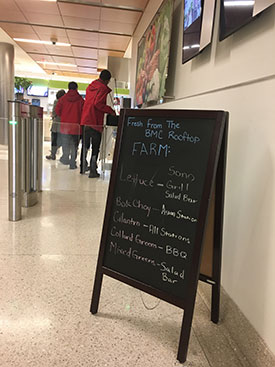
A sign advertises BMC’s farm offerings on a sign outside the cafeteria entrance. (Photo: Jaime Kaiser)
ALLEN: My biggest surprise within the first week was just how well the plants did. I was really worried that they weren’t going to grow that well, and they were so happy and grew faster than anywhere I’d ever farmed. We planted and then five weeks later we were harvesting radishes, salad mix, lettuce heads, and that definitely surprised me.
KAISER: The farm takes up 2400 square feet of space, just 1/16 of an acre. Nevertheless, Lindsay and her team were able to grow over 5000 pounds of produce in 2017, and they hope to grow a similar amount this year.
All her crops are organized in neat, long rows of milk crates.
ALLEN: So we have 2300 milk crates here, and then each milk crate has a recycled, woven fabric – plastic fabric – that allows for drainage and air to move.
KAISER: The farm works in tandem with other initiatives like a food pantry for food-insecure patients and a hospital farmer’s market.
ALLEN: It’s really integrated into a fuller picture of what it means to care for people in a way that I think more hospitals should be doing.
[FOOTSTEPS]
ALLEN: So if we walk over here, this… so this was a section that was planted first on the farm. And it’s a mix of crops that I can keep harvesting from. So this is like collard greens, kale here – that I will continue for like two to three months to harvest and make bundles from. And then we’ve intercropped some of our more summer-specific crops so we have Poblano peppers here, I have a lot of bell peppers, a few habaneros.
KAISER: To our right, a series of wire domes poke out of a row of crates.
ALLEN: These are all hoop houses that we added for season extension. So in the springtime and in the fall we cover this with row cloth, these hoops, and that way it mitigates against frost and creates a little bit of a microclimate so that we can start earlier than if it were just all open. And then in the fall that allows us to keep growing until about mid-November.
[MORE WALKING]
KAISER: Allen leads the way to another set of crates.
ALLEN: Let’s see… this is a huge patch of carrots that are almost ready. I planted them to time so that when we have our summer camps up here in two weeks, the kids can help me harvest carrots because it’s a really rewarding and fun experience if you haven’t harvested carrots. You have this green top and I kind of think of it as a nice surprise when you pull in out. Or, I’ve had kids up here that scream as they pull it out not knowing what was actually below the soil.
KAISER: Then she walks around to the other side of the row.
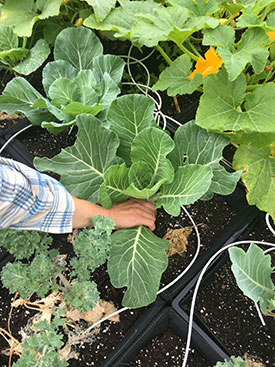
Lindsay harvests collard greens from the soil. (Photo: Jaime Kaiser)
ALLEN: These are all the cucumbers on this side. So we have three different varieties of cucumbers. Then we have Bock Choy that’s interplanted and basil plants as well interplanted with the tomatoes and the peppers.
KAISER: Interplanted to maximize urban growing space, and encourage a variety of beneficial insects to pay a visit.
ALLEN: I try to think of this farm as much of an ecosystem as possible. How do we keep all of the scraps that we aren’t actually using for food, keep them on site, so that we can continue to create soil and compost up here and then we also have bees to pollinate. And… and then we get honey. So that’s always a plus with keeping bees.
KAISER: Where are the bees?
ALLEN: They are – we can walk over here…
ALLEN: They will be inside their hives today but we can peek at them… oh, there are a few coming in and going, they’re brave.
KAISER: Two bee boxes, each crammed with thousands of bees!
[FADE IN CAFETERIA / LOBBY AMBI]
KAISER: For a look at how all that farm fresh food makes it to patient plates, I head over to the cafeteria.
BURG: Hi, my name is Tracey Burg. I’m the culinary nutrition manager at Boston Medical Center’s Teaching Kitchen.
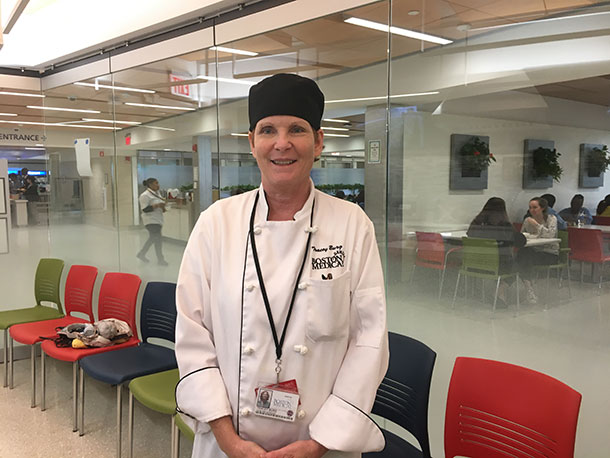
Tracey Burg is a registered dietitian and the Head Chef of the teaching kitchen. (Photo: Jaime Kaiser)
KAISER: The teaching kitchen is a healthy food project that got its start before the farm. Each class incorporates fresh food from the farm into cooking lessons that demonstrate BMC’s food as medicine philosophy.
BURG: Our classes are free, we invite anybody to come in, but also people with heart disease, diabetes, cancer, renal patients. They come in for classes and we talk about disease-specific foods and cooking techniques that are healthy for them.
KAISER: I visit Tracey during one of her classes. For her first dish, she whips out a blender from one of the cabinets behind her.
BURG: Alright, so, this sherbet recipe has two ingredients… this mango here… and then we’re gonna add one cup of vanilla greek yogurt. And then a little bit of water.
And then we’re gonna blend this up.
[BLENDER WHIRRS]
KAISER: She also adds a dollop of honey – straight from the bees on the farm.
For the main course, Tracey grabs a cucumber out of the fridge and begins to chop.
BURG: Tabouleh is wheat chopped up. And we’re gonna put some parsley in here. You can use mint too. Parsley and mint taste delicious in tabouleh. I was taking the mint from our farm yesterday.
KAISER: Tracey says the farm has been a huge asset to her work in the kitchen.
BURG: Oh, well, the farm’s great. I mean, I get my produce from there. But it’s also, it’s a learning space for us too. So I bring all my groups up there at some point during the growing season. And we pick the vegetables up there, we bring it down to the kitchen, and we cook it. And so it’s kind of like farm to table right in front of them.
KAISER: The farm has been a remarkable addition to the neighborhood too – the South End of Boston was once considered a food desert. Again, farm manager Lindsay Allen.
ALLEN: There’s a few grocery stores now popping up, but it’s a pretty intense part of the city that not only has food access issues but there’s also no green space around here.
KAISER: Despite the role that fresh fruits and vegetables have in staying healthy, people are often shocked to learn about the hospital’s rooftop farm.
ALLEN: Most people associate hospitals with terrible food, which is really interesting because right when we’re at our most vulnerable at hospitals, you’d think that would mean we need nourishing food.
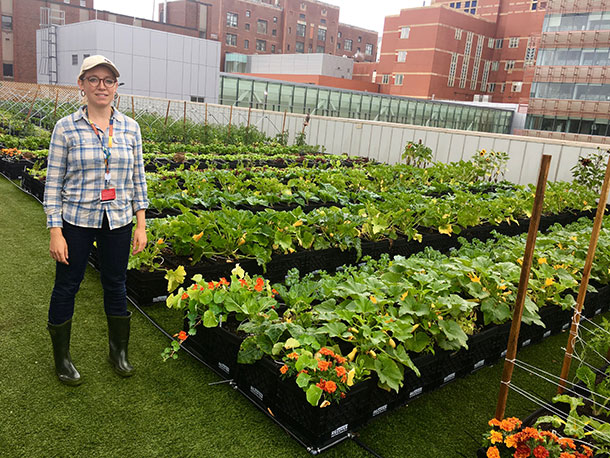
The BMC farm produced roughly 5000 pounds of produce in 2017. (Photo: Jaime Kaiser)
KAISER: Lindsay says that Boston Medical Center’s approach is a holistic take on healthcare that looks beyond the immediate needs of their patients. Right now, they’re also looking forward to a bumper crop of tomatoes.
CURWOOD: Thanks for that report, Jaime. Hey, did you get try anything?
KAISER: Yep, I did… that mango sherbet is awesome.
CURWOOD: I’m jealous.
Related link:
More about the farm project
The Place Where You Live: Anchorage, Alaska
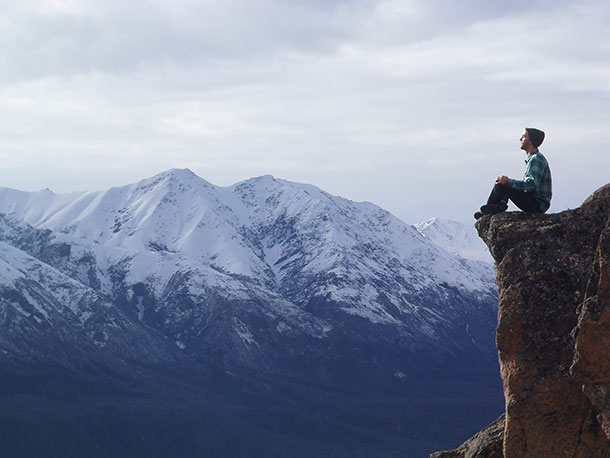
In her essay for Orion Magazine, Sasha Johnson writes, “We head to the backcountry in Hatcher Pass, find ways to make the winter last through summer’s short gasp.” (Photo: Sasha Johnson)
[MUSIC: Edward Sharpe and The Magnetic Zeroes “Home” from Edward Sharpe and The Magnetic Zeroes, Rough Trade Records, 2009]
CURWOOD: We head to Anchorage, Alaska now for another installment in the occasional Living on Earth/Orion Magazine series The Place Where You Live.
Orion invites readers to submit essays to the magazine’s website to put places they care about on the map, and we give them a voice.
[MUSIC: Mary Youngblood “Within My Heart” from Beneath the Raven Moon, Silver Wave Records, 2002]
JOHNSON: My name is Sasha Johnson, and this is my essay called, “Anchorage, Alaska.”
Anchorage, Alaska. Home and point of departure. Nestled along a sloping peninsula between the mountains and the sea. Young, adventurous, bold. Addicted, drunken, old. Squeezing out the space between the Chugach and Cook Inlet, climbing up the hillside, stretching north and south. Digging and drilling and mining and tilling. Disorganized as driftwood. Sliced up and down by the highway, tucked into neighborhoods cockeyed and rent-choked. Sporting proud your homes on the heights overlooking the bore tide rolling in Turnagain Arm, eagles and geese flying low over Potter Marsh, with a view to Fire Island where the windmills eke out their promises. You bedeck your winter streets with gravel, coat them with ice and snow, groom them with snowplows and brush them clean for summer.
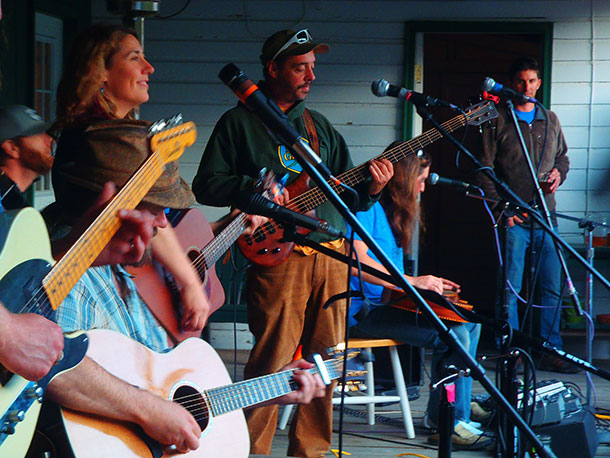
The “homegrown song” Sasha Johnson mentions in her essay was by local band Melissa Mitchell and the Sociables, in Hope, Alaska. (Photo: Sasha Johnson)
We live outside in all weathers, we hitchhike, we hold cardboard signs. We head to the backcountry and Hatcher Pass, find ways to make the winter last through summer’s short gasp. We roost with the ravens and run Native Corporations. We are mountaineers and mistresses, hobos and halibut fishermen. We dip-net for salmon and hunt oil on the North Slope, two weeks on, two weeks off. Bush pilots and line cooks, airmen and officers, bankers and railroaders, coal men and climbers.
We call you home, Anchorage, you beggar, trouble-maker, reckless one, dreamer. Heart of Alaska. Independent and willful but keen for community, just a big city spread with a small-town rumor. Let’s drive out to catch the festival. I’ll listen to your music again by anybody’s fire, barefoot, eyes closed, rocking the stage with homegrown song. Taste your salmon, smoked and grilled and salty on my tongue. Feel your cold bite in the morning. Catch the scent of sprucewood and birch, wet with dew.
I head over a sunset ridge and you disappear from view.
[MUSIC: Mary Youngblood “Within My Heart” from Beneath the Raven Moon, Silver Wave Records, 2002]
JOHNSON: I have lived in Anchorage for two years only. It’s new for me. But I’m 36 and it’s the first place that I ever felt like I could really call home. And I had that feeling immediately in the geography, in the landscape, the mountains, the rivers, the forests, and then in the people. The people felt like my people for the first time. Strange, eccentric, adventuresome people who were willing to risk, who loved the outdoors and were willing to fight for what they wanted, even if it isolated them from other people. I felt a kinship with those people.
I teach, but I also ski. And I know mountaineers and I’ve spent time with them. I wanted to be a bush pilot. And I’ve seen all of our homeless tramps and hobos on the street. So, these are familiar faces to me, these are people I’ve known and some of them are things I’ve done. Some of the references in this essay are experiences I’ve had. Some of them are people I’ve known and some of them are things I hope to do. I see Anchorage as a place of dreams for many people and some of these dreams are broken.

“Heart of Alaska. Independent and willful but keen for community; just a big city spread with a small town rumor," writes Sasha Johnson in her essay. (Photo: Sasha Johnson)
Everybody that I’ve met has a story and not all of them want to tell that story. There are many reasons why people come to Alaska and end up in Anchorage and you can feel the yearning in the stories of the people that you get to meet. You see poverty, you see wealth, you see people struggling daily all around you and you see success. Families, children. It’s a place where people struggle to make it and struggle to build a life. And it’s a beautiful place but it’s a place – you can feel the struggle.
[MUSIC: Mary Youngblood “Within My Heart” from Beneath the Raven Moon, Silver Wave Records, 2002]
CURWOOD: That’s Sasha Johnson on her new home in Anchorage, Alaska. You can find pictures and details about Orion Magazine and how to submit an essay about the place where you live, at our website, loe.org.
Related links:
- More on the band Sasha mentions
- Sasha Johnson’s Flickr account
- Sasha Johnson’s essay In Orion Magazine
- The Place Where You Live essays in Orion Magazine
[MUSIC: Ole Mattiessen, “Love Song,” on Stunt Records 2017]
KAISER: On the next Living on Earth, combat veteran divers use their military training to help save marine life.
RITTERHOFF: Let’s take the training these guys already have and now repurpose it and retool them to do conservation work after they get out of the military. They want to save the world, that’s who they are.
KAISER: From combat to conservation, that’s next time on Living on Earth.
CURWOOD: Living on Earth is produced by the World Media Foundation. Our crew includes Naomi Arenberg, Bobby Bascomb, Thurston Briscoe, Savannah Christiansen, Jenni Doering, Anna Gibbs, Don Lyman, Maggie O’Brien, Aynsley O’Neill, Sarah Rappaport, Jake Rego, Adelaide Chen, and Jolanda Omari.
KAISER: Tom Tiger engineered our show, with help from John Jessoe. Alison Lirish Dean composed our themes. You can hear us anytime at L-O-E dot org – and like us, please, on our Facebook page – PRI’s Living on Earth.
And we tweet from @livingonearth.
I’m Jaime Kaiser.
CURWOOD: And I’m Steve Curwood.
Thanks for listening!
ANNOUNCER: Funding for Living on Earth comes from you our listeners and from the University of Massachusetts, Boston in association with its School for the Environment, developing the next generation of environmental leaders. And from the Grantham Foundation for the Protection of the Environment, supporting strategic communications and collaboration in solving the world’s most pressing environmental problems. Support also comes from the Energy Foundation, serving the public interest by helping to build a strong clean energy economy.
ANNOUNCER 2: PRI, Public Radio International.
Living on Earth wants to hear from you!
Living on Earth
62 Calef Highway, Suite 212
Lee, NH 03861
Telephone: 617-287-4121
E-mail: comments@loe.org
Newsletter [Click here]
Donate to Living on Earth!
Living on Earth is an independent media program and relies entirely on contributions from listeners and institutions supporting public service. Please donate now to preserve an independent environmental voice.
NewsletterLiving on Earth offers a weekly delivery of the show's rundown to your mailbox. Sign up for our newsletter today!
 Sailors For The Sea: Be the change you want to sea.
Sailors For The Sea: Be the change you want to sea.
 The Grantham Foundation for the Protection of the Environment: Committed to protecting and improving the health of the global environment.
The Grantham Foundation for the Protection of the Environment: Committed to protecting and improving the health of the global environment.
 Contribute to Living on Earth and receive, as our gift to you, an archival print of one of Mark Seth Lender's extraordinary wildlife photographs. Follow the link to see Mark's current collection of photographs.
Contribute to Living on Earth and receive, as our gift to you, an archival print of one of Mark Seth Lender's extraordinary wildlife photographs. Follow the link to see Mark's current collection of photographs.
 Buy a signed copy of Mark Seth Lender's book Smeagull the Seagull & support Living on Earth
Buy a signed copy of Mark Seth Lender's book Smeagull the Seagull & support Living on Earth

